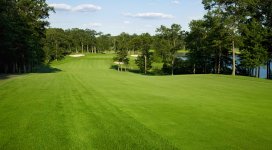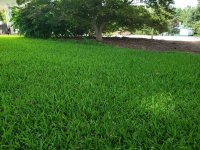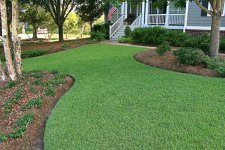
Getting to know your lawn will save you from mistakes
This month’s column is inspired by a recent meeting I had with a potential customer. I met with him to discuss possibly re-sodding his lawn.
His lawn was a lush St Augustine grass. He bought his home last summer so this spring was his first in his new home and his first with having a St Augustine lawn. Unfortunately, the ice we experienced here in North Texas back in December literally killed his lawn. Only small remnants here and there remained of his St Augustine lawn.
The homeowner felt that if he fertilized his lawn it might come back. He fertilized right before our meeting.
If I had only arrived a little sooner.
In discussing the sod job, I asked the customer if he had used any chemical applications on the lawn recently. I was looking down at the ground and saw small pellets. He said he had just put down some Scott’s Turfbuilder® on the lawn that morning.
This was a huge mistake. Thankfully, he had not watered it in yet. I asked him to use his blower and get as much of the product out of his lawn as soon as possible.
What was the problem? He used a product made for Bermuda grass on a lawn that had St Augustine. Two things are wrong with that.
1 – The level of nitrogen in Turfbuilder is much, much more than St Augustine can handle. It simply burns the turf up, slowly day by day. The lawn begins looking horrid and just continues to get worse. No amount of watering will help. Turfbuilder and other Bermuda fertilizer products are going to have anywhere from 27 to 37 on the nitrogen level. St Augustine (and Zoysia) cannot withstand the high nitrogen.
Putting it down before sodding creates a situation where the offending high nitrogen will be in contact with the sod’s delicate roots.
2. Turfbuilder is sold in a weed/feed version that is popular. The weed killer in this product will kill St Augustine.
This was not the first time I have run into this problem. In fact, I’ve seen it happen fairly regularly over the years.
In one case, the homeowner had applied the Turfbuilder on his St Augustine lawn – and then watered it in. Twice. For this lawn, it took another year for it to get back to normal.
So we’ll talk about the unique characteristics of North Texas’ three main turf types – Bermuda, St Augustine, and Zoysia today so hopefully folks can avoid a self-inflicted disaster that I described, above.

BERMUDA – Bermuda is a thin-blade grass that is native to most of Texas. This means, if you have a Bermuda lawn and left for five years, your Bermuda lawn would still be there when you returned. Bermuda is very resilient. It recovers quickly from pest attacks. It seldom suffers from lawn fungus. It grows and spreads fast and is drought tolerant.
What’s not to like about that? Well, Bermuda also has its limitations/negatives, too.
Bermuda will not grow or survive in a shaded environment. It requires full sun. So if you have trees in your yard, Bermuda is probably not your best choice for turf. Bermuda is a very thin bladed turf and is often susceptible to weed growth because weed seeds that are blown in by the wind fall easily to the soil level through the thin blades. Bermuda goes dormant early, by comparison to other turfs, during Fall. It is also late to emerge from dormancy. This can cause a struggle for homeowners trying to keep their lawns weed-free.
Regular and repeated applications of pre-emergent will help curtail the weeds.
There are several varieties of Bermuda. The Bermuda Tif 419 is a popular choice. It is a straight-blade grass that can be kept short (unlike some other turfs) and is often used on golf courses. Celebration Bermuda is another variety and is growing in popularity because of enhanced drought tolerance and is a slower growing turf.
The key to having a lawn that will survive pests and choke out weeds is to get your Bermuda turf as healthy as possible with a regular schedule of fertilizations. You can also overseed Bermuda, adding seeds to existing turf to gain a thicker turf.

ST. AUGUSTINE – This turf is farmed in Gulf Coast region of Texas, so most all of the sod coming to DFW is coming from places like Wharton and Brenham, Texas. The black clay soils down there are much the same as our own soil here.
So consider it a coastal grass. This means that St Augustine is native to a climate that is warmer than ours here in North Texas. Each winter, St Augustine will partially die off (recede) and each Spring, will grow and spread again to reclaim those areas that died off. However, we occasionally experience a winter with ice and prolonged sub-freezing temperatures. This can cause great damage to a St Augustine lawn.
If you know what to watch for and when to watch for them, you can easily manage a successful St Augustine lawn and knock out any problems you might encounter through the season. Grub worms must be treated in mid to late May. Be watchful for Chinch bugs in July and August. And lawn fungus can be a problem in Fall. Those issues can be either prevented or resolved just by knowing what the problem can be. Adjust watering to morning starts in Fall to prevent fungus.
Of the three turfs, St Augustine might be the most popular here in DFW and is renowned for its large, wide blades and thick growing habit, making it a wonderful turf to have. It will spread fast, using “runners” to spread itself. In a mixed-turf environment (example – St Augustine and Bermuda), St Augustine will be the more dominant turf and if cared for correctly, will overtake the Bermuda.
When fertilizing, you want to choose a product that is specifically made for St Augustine turf. Products such as Fertilome’s St Augustine Weed and Feed, and Scott’s Bonus S® are very good options. In each case, it will say on the bag that it is intended for St Augustine lawns. This is important because this turf cannot withstand the high nitrogen products that Bermuda requires. Instead, it does best with a 15-19 level of nitrogen.
St Augustine performs well in full sun, partial sun or shaded environments.
There are several types of St Augustine that are available. The variety that performs the best in our region is Palmetto St Augustine.

ZOYSIA – There are many varieties of Zoysia turf and they can look quite different from one another. There is Emerald Zoysia and Xeon Zoysia which are beautiful types of Zoysia. But the variety I feel does best in our region is Palisades Zoysia. Palisades has a blade width that is about half the size of St Augustine but twice the size of Bermuda.
Palisades is a slower growing turf. That means it spreads slowly, too. But on the positive side, that also means you may only need to mow once every two weeks instead of weekly.
Chemically, you would be using much the same products that you would use on St Augustine. Like St Augustine, Palisades Zoysia will thicken like a carpet and will choke weeds out. Like St Augustine, Zoysia prefers a mild fertilizer.
From time to time, North Texas is hit with pests and one of those is the dreaded Army Worms. Ironically, Army Worms won’t feed on a Zoysia lawn.
Palisades does not require as much water to grow as St Augustine does and performs equally well in full sun or shaded environments.
Just knowing more about what your turf requires and other characteristics will help you realize a healthy turf. Remember to keep the mower blades sharp, mow at a higher level during warm weather (at least 3.5-4 inches), and during June-July-August, start your watering cycles in the evening, optimally at 11 p.m. This allows much more time for the grass and water to be together, creating a healthier turf. On Labor Day, we will go back to morning starts until mid-spring returns.


